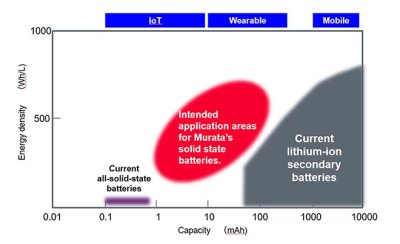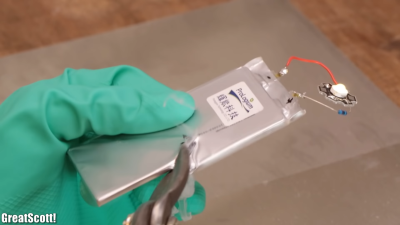
Solid state batteries have long been promised to us as the solution to our energy storage needs. Theoretically capable of greater storage densities than existing lithium-ion and lithium-polymer cells, while being far safer to boot, they would offer a huge performance boost in all manner of applications.
For those of us dreaming of a 1,000-mile range electric car or a 14-kilowatt power drill, the simple fact remains that the technology just isn’t quite there yet. However, Murata Manufacturing Co., Ltd. has just announced that it plans to ship solid state batteries in the fall, which from a glance at the calendar is just weeks away.
It’s exciting news, and we’re sure you’re dying to know – just what are they planning to ship, and how capable are the batteries? Let’s dive in.
Benefits of Solid State over Li-Ion/Li-Po

If you’re unfamiliar with solid-state batteries, the basic idea is to build a battery using only solid materials, eliminating liquid electrolytes as used in lithium-ion batteries. The hope is that this would allow the use of lithium metal as an anode material, which promises a far higher energy density than existing battery designs. Raw lithium metal isn’t used in current battery anodes as it grows harmful dendrites that quickly destroy a battery. The solid state design also brings other benefits, such as greater safety due to the elimination of the flammable liquid electrolyte, and thus faster charging as temperature limits become less critical to avoid blowing everything to pieces. The compelling benefits are there, yet have thus far proved difficult to achieve.
As for Murata, it’s a company well known for producing multilayer ceramic capacitors (MLCC) and other similar devices, though they have been branching out into battery technologies after purchasing Sony’s battery division back in 2017. With these new solid state batteries, the company hopes to stake its claim as a major competitor in the battery market, after having invested hundreds of millions of dollars in the business.
Starting Small, But Permanent

According to Murata’s own report from 2019, their new batteries will be aimed at the wearables and Internet of Things market. The batteries will be on the order of 2 to 25 mAh in capacity, based on graphics in the press release, with energy densities in the realm of 500 Wh/L. This puts the batteries in the realm slightly above the performance of current lithium-ion cells. It also far exceeds existing solid state designs, currently only really used in pacemakers and other very-low-power applications. The company aims to eventually deliver 100,000 parts a month, though will ramp up production slowly over the next 12 months or so.
Murata’s batteries will thus be small, compact, and not wildly powerful. However, their solid state nature brings one exciting benefit — they’ll be able to be soldered directly to PCBs in much the same way as any other component. Solid state batteries have many admirable benefits like these, in fact. By virtue of eliminating liquid electrolytes, the batteries are typically non-flammable and far hardier than traditional lithium-ion cells.

Everyone Wants a Piece of This Emerging Sector
As we’ve reported, BMW are betting big on the technology, even as competitors like Fisker have fallen by the wayside. Toyota also intend to throw their hat in the ring, with just about every other automaker involved in one way or another. The reason is simple: if solid state batteries can live up to their promises, electric cars could see a huge performance boost almost overnight. Batteries with higher energy density would provide for much longer range between recharges, while the lack of flammable liquid electrolyte would lessen overheating risks and potentially allow faster charge times. These two fixes would leave the electric vehicle world to then solely contend with the infrastructure issue, which is already well on the way to being solved in some locations. It’s compelling stuff.
For all that to happen, though, will require plenty of research and development. That’s well underway, of course, with Electronic Design reporting on multiple cutting-edge projects in the solid-state battery space late last year. The inherent difficulty most projects face is in the separator material. Placed between the anode and cathode, the separator must allow for lithium ions to pass freely from one side of the battery to another, while resisting the formation of lithium dendrites that could short circuit the battery. There’s a wide variety of approaches and chemistries at play, with it being anyone’s guess as to which, if any, will come out on top.
There’s some fundamental science to be done yet, and with hundreds of millions of dollars pouring in to research labs around the world, there’s plenty going on. YouTuber [Just Have a Think] has been following along with these developments, and covers the Murata development along with the state of play in the automotive scene, if you want to dig a bit deeper into the developments.
We can’t wait until these devices are shipping en masse, particularly as densities and current capacity increase. The advent of a lighter, more powerful, and crucially, more robust battery should herald a new wave of projects and technologies in much the same way that lithium-ion batteries did 30 years ago.
[Main image via Murata online exhibition about solid state batteries]
0 Commentaires